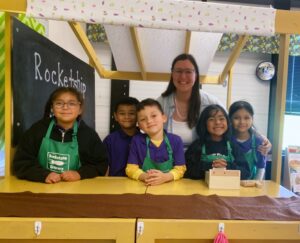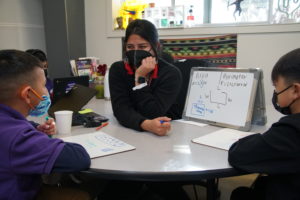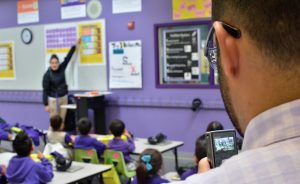
How I Taught My Elementary Class About Digital Literacy During Distance Learning
By Waleed Shaban, Integrated Special Education Teacher, Rocketship Rising Stars
I still recall walking into my first marketing class 7 years ago. Before introducing herself, our professor played a 45-second BMW commercial. For the next 30 minutes, we analyzed every aspect of the ad. We looked at colors chosen and dialogue spoken and the choice of music included. We examined how each and every aspect was intentionally chosen to persuade us to feel more positively about that car. Advertisements and digital content aimed at children are no different. I’ve had multiple conversations with families explaining that, no, you don’t have to spend money on Fortnite or Roblox (free, popular video games) in order to gain a competitive advantage. However, students see famous streamers and YouTubers marketing cosmetic items and neat emotes that make it seem like we have to have the latest thing. It is appalling how the digital world sways to make decisions in our everyday lives, yet it’s a reality we can help our students be better prepared for.
This virtual school year, our students interact with more media than ever before. Students are now logged on devices for 6+ hours per day for school. Game and social media companies gear vast amounts of content towards children on a daily basis, so even when students aren’t learning in a school environment, many still love to be in front of their screens. All that time leads to endless opportunities to soak up content.
It felt critical to make sure my students understood the way our digital world works. My students have engaged in physical, real-life classroom communities in the past. They knew the typical recess rules. Now, the rules might not apply the same way. Recess could now mean students stealing a quick game of Fortnite while lunch is prepared by a family member. It could mean calling a cousin or friend via FaceTime. And all of this happens while teachers are away, tending to their own matters.
While I can’t control what happens outside my classroom, I wanted to make sure my students walked away from our lesson with these 3 major ideas in their heads as I guided them through a social-emotional lesson on digital literacy.
[Check out my SEL digital literacy lesson here to help create your own!]

1. We are still a community, even when we’re miles apart from one another.
Our discussion began with trying to define the word “community.” We knew a community consisted of a group of people. The question was, could we still be a community even when we weren’t in the same geographic area? I saw students’ shaking their heads “no.” Seeing that response reminded me how important this lesson was.
2. The content we share has power and impacts others.
Our class then read a story of a young girl who posted an anonymous insult on a friend’s Instagram account. The girl in the story didn’t realize the impact she would have. She didn’t think about what would happen when her friend read the phrase, “what a bunch of ugly freaks” on her post. The girl said she meant it as a joke. That didn’t matter. Across the Zoom grid, there were wide eyes and mouths agape. How could someone say that? This immediately led to a discussion of the power of words – on how our words either create or harm our community.
On the internet, words have the potential to live forever. They can travel without any responsibility taken by their owner. They can damage their targets. My students in third grade aren’t active on Instagram, but they are on other platforms such as TikTok, Roblox, and Minecraft. These communities have similar features where people can voice their opinions.
3. We must be wary of what others share with us and how it impacts us.
I taught my students that when we receive a message that is negative in nature, we need to stop what we’re doing in the moment. This is the first step. Afterward, we must think about if it’s actually true. Does the person mean that, and would they say it to your face? Do you believe that about yourself? Why would the person say that – are they trying to feel better about themselves?
As we saw how what we can say has the potential to hurt others, we spent time reflecting on our own experiences online. It’s funny to call our 8 and 9-year old students “veterans” in the virtual world, but they are. Even pre-pandemic, they have engaged in a lifestyle of communication unlike generations prior. We shared (private messages in the chat to the teacher) if we had ever felt hurt by a message. The result was astounding. It’s easy to forget about the sheer amount of touchpoints students make with others online. After the school day, batteries drain on iPads playing Roblox, making FaceTime calls, and much more. With that amount of interactions, negative messages are bound to come up.
At first, I was hesitant to deliver such a personal lesson when I actually couldn’t sit or stand close to my students. As a teacher, it can feel quite difficult to engage students in virtual content. When we had a chance to discuss digital community, messages, and its impact on us, the floodgates opened up. Our chat felt more alive than it ever had. I heard from students who usually took full advantage of the Zoom “mute” feature. Why is that? Discussing our role in our community is personal. It’s important to every student. It’s refreshing in an online classroom.
This lesson led to more discussions in the coming weeks. We discussed how advertisers make us feel, which apps were safe to use, and how we could use the chat feature to empower others. A topic like this helped us connect with families on a deeper level, as well. In our check=ins, we were able to talk about more than merely data points on the latest assessment.
I don’t know if my students will work in digital advertising or marketing in the decades to come. Yet, you don’t need to work in or study the industry to realize its impact on our everyday lives. A 45-second car commercial has the power to influence our thinking and sway our decisions. A comment on an Instagram post has the same, if not more, power. It’s time to make sure our students understand that power.
Published on March 22, 2021
Read more stories about: Uncategorized.
Back In The Classroom
How Co-Teacher Collaboration Can Benefit Your Classroom
Featuring Alejandra Chavez, Education Specialist at Rocketship Mosaic Elementary | June 10, 2024
Hear from Ms. Aly about how a small team of educators can make a big difference in student outcomes through thoughtful planning, focused collaboration, and personalized accommodations. Ms. Aly was one of our highest-performing educators in California for the 23-24 school year.
Read more ⟩How This 5th Grade Teacher Brings Positive Role Models into his Classroom
Featuring Brandon LaBella, 5th Grade Teacher, Rocketship Spark Academy | March 1, 2023
In this 30-minute chat, you'll hear what keeps this teacher motivated, the power of relationships, and how he brought in speakers to discuss career paths and life perspectives.
Read more ⟩How to Spark Joy in ESL Classrooms with a Multilingual Learning Clubhouse
Featuring Ms. Amy De La Rosa, Multilingual Specialist, Nashville Northeast Elementary | June 1, 2023
Listen in to an audio interview with Amy De La Rosa, a Multilingual Specialist who has worked as an educator for over 14 years and found an innovative way to help her students learn English in a more accelerated, playful way.
Read more ⟩Supporting Parents of Multilingual Students in Family/Teacher Conferences
Emma Volpe, Rocketship United Academy | June 1, 2022
Get thoughtful insight on how to create a more inclusive family-teacher conference environment.
Read more ⟩5 Ways to Strengthen Relationships in the Classroom
James Cross, Assistant Principal, Rocketship Nashville Northeast Elementary | February 20, 2022
A new age of education calls for a new level of connection. Here are some key tips to strengthen relationships in your classroom this school year.
Read more ⟩How BurnIn Mental Strategies Can Improve an Educator's Experience
Rocketship Public Schools | February 21, 2022
Learn how teachers use BurnIn mindset strategies to focus on strengths, deepen relationships, and navigate challenging times.
Read more ⟩5 Ways School Leaders Can Coach and Support Teachers
Eesir Kaur, Director of Professional Development | October 15, 2020
Are you a school leader looking to coach your teachers more effectively? Here's what works for us.
Read more ⟩










